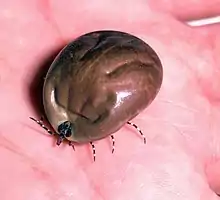alloscutum
See also: scutum
English


Note the folds in the skin of the alloscutum, that show where the muscles are attached, that enable the tick to roll over if it should fall on its back.
Etymology
From Ancient Greek ἄλλος (állos, “other”) and from Latin scūtum (“shield”)
Noun
alloscutum (plural alloscuta)
- (zoology) the flexible part of the dorsal body wall behind the rigid scutum in a hard tick, particularly a female, — the alloscutum is the part of the body wall that must stretch to accommodate the blood that the tick swallows when it engorges in preparation for laying eggs.
- 2008, Heinz Mehlhorn, Encyclopedia of Parasitology isbn=978-3-540-48994-8:
-
This article is issued from Wiktionary. The text is licensed under Creative Commons - Attribution - Sharealike. Additional terms may apply for the media files.